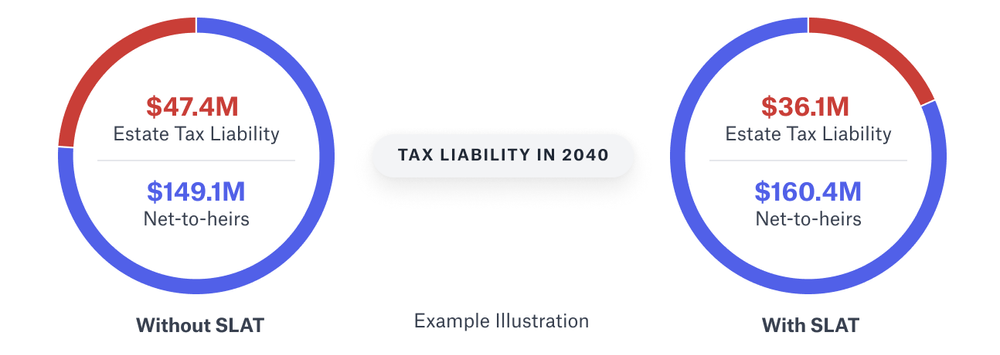 Vanilla
Vanilla
What is a spousal lifetime access trust (SLAT), and how does it work?

What is a spousal lifetime access trust (SLAT)?
A Spousal Lifetime Access Trust (“SLAT”) is an irrevocable trust set up by an individual (the “donor”) during his or her lifetime for the benefit of the individual’s spouse and if, desired, other family members.
How does the SLAT Work?
A SLAT is created under a trust agreement, which contains the terms of the trust and the name of the individuals or entity that will act as trustee (typically a trusted friend or advisor).
A SLAT is funded by way of a gift from the donor to the SLAT. During the donor’s lifetime, the trustee can make distributions to the donor’s spouse, as well as to any other beneficiaries named in the trust agreement. On the donor’s death, all assets transferred to the SLAT (plus any appreciation) will pass to the spouse and other beneficiaries tax-free. Because this trust allows individual donors to take advantage of the federal gift and estate tax exclusion (currently set at $13.61 million per person), SLATs can be powerful tools to transfer significant assets to beneficiaries while incurring only minimal tax liability.

What are the tax benefits of a spousal lifetime access trust(SLAT)?
The primary benefit of the SLAT is that the donor’s spouse is a beneficiary, and so the donor can continue to benefit indirectly from trust assets through distributions to the spouse. Given that the exemption amount is at a record high, many individuals are considering gifting significant amounts of wealth before the exemption is set to be reduced at the end of 2025 to $5 million (adjusted for inflation). However, parting with such large sum can be a daunting thought for many individuals. For some, it represents a lifetime of work to amass such wealth, while others are happy to make a large gift family members, but worry that they may change their mind in the future about how much they would like their descendants to inherit. Another common concern is that if the market should fall and therefore deplete the assets not gifted, they may need the gifted funds in the future for living expenses.
In these cases, or any others where flexibility is desired, a SLAT may be the ideal vehicle into which the individual can make a gift, because assets can always be distributed to the beneficiary spouse if funds are needed in the future for any reason. By including the spouse as a beneficiary of the trust, there is essentially an “escape valve” built in that allows the funds to be returned indirectly to the donor, if needed.
SLAT estate and tax planning in action
As an example of how a SLAT could work, consider married couple William and Meredith, who have $35 million in assets. William established a SLAT for the benefit of Meredith, and gifts the total amount of his lifetime exclusion amount ($12.92 million) into the trust. The remaining $22.08 million is then used to maintain their lifestyles, leaving the SLAT assets untouched to appreciate until Meredith’s death.
William predeceases Meredith, and his remaining assets pass to her. As the law currently stands, the estate exclusion will decrease to $5 million in 2026. But William’s previous gift was locked in using the 2023 exclusion amount and so the SLAT assets are completely protected against any estate and gift taxes on William’s death. Although Meredith could always receive a distribution from the SLAT should she need additional funds, she does not take a distribution and instead uses her remaining assets and any inherited from William to maintain her standard of living for her remaining years.
When Meredith passes, the SLAT then distributes the remaining funds, including any appreciation since the establishment of the trust, to the beneficiaries named in the trust agreement. This distribution is notably without any additional estate taxes, meaning that William’s estate exemption may significantly benefit their heirs. Meredith’s other assets over the exemption amount at that time will be taxed at 40%.
The impact of William’s SLAT is that the family may ultimately retain millions of dollars of assets that otherwise would have been surrendered as a taxable part of the estate. This retention is even more impactful if the assets have appreciated significantly since the initial gift into the trust.
When SLATs are the right or wrong choice
SLATs are a great choice when the individual donor is married and would like to have the option for the trust to make distributions to his or her spouse in the future. Since the key to the SLAT planning is that the beneficiary spouse can receive distributions, it is important that the donor and spouse are in good health and that donor has a significant degree of confidence in the stability of the relationship with the non-donor spouse. This is because if the individuals were to get divorced or the non-donor spouse were to pass away, the donor would no longer have indirect access to the trust funds.
To mitigate the risk of divorce or death, it is possible to set up two SLATs where each spouse serves as donor spouse and beneficiary spouse, respectively, so that each spouse has direct access to one trust. This allows both spouses to use their lifetime gift tax exemption amounts and reduces the risk that the donor spouse would lose indirect access to the trust funds on a divorce or if the beneficiary spouse passes away. However, if dual SLATs are created, it is imperative that the trusts be carefully written to be different from the other and designed to avoid the “reciprocal trust” doctrine, which the IRS could use to invalidate the tax benefits of the trusts.
SLATs in brief
Couples with significant net worth should consider a SLAT for its potential benefits in estate planning. It is a tool that works in conjunction with other aspects of estate planning to minimize the estate tax burden without eliminating all access to the funds placed within the trust, giving it unique benefits compared to other forms of estate planning.
Depending on your situation, a SLAT may serve as an essential part of your estate planning. Nevertheless, each individual is unique, so you need to have the most up-to-date, comprehensible information. Vanilla provides powerful tools that make these financial situations understandable, helping you form the best plan possible for your family’s future.
About Vanilla
Vanilla is the Estate Advisory Platform, purpose-built to enable financial advisors to build deeper relationships with their clients and empower clients to build and protect their legacy. From robust and easy-to-understand visualizations of complex estates, detailed diagrams of how assets transfer to future generations, to ongoing estate monitoring, Vanilla is reinventing the estate planning experience, end-to-end. Learn more about Vanilla’s estate planning software.
Media inquiries: Please contact press@justvanilla.com
This article is for educational purposes only and should not be considered legal advice. If you feel that the information in this article is pertinent to your situation, you may wish to consult a qualified attorney for advice tailored to your circumstances.
FAQs
What assets are best to put in a slat?
Which assets should go into a SLAT will depend on your personal situation and goals. Here are some common assets that could be considered for inclusion in a SLAT:
Cash and cash equivalents: This includes savings accounts, money market funds, and certificates of deposit (CDs).
Securities: Stocks, bonds, mutual funds, and other publicly traded securities can be included in the trust.
Real estate: Residential and commercial properties can be transferred to the SLAT, subject to any legal and tax considerations.
Business interests: If you own a closely held business, you may transfer some or all of your ownership interest into the trust.
Intellectual property: Patents, copyrights, and trademarks can be included in the trust if applicable.
Other valuable assets: Any other valuable assets or personal property that you wish to transfer to the trust.
What are the pros and cons of a spousal lifetime access trust(SLAT)?
A spousal lifetime access trust can be an excellent way to move assets out of an individual estate for tax purposes while ostensibly retaining some control of the funds because it is controlled by the spouse. At death, assets in the trust as well as any appreciation of those assets will pass to the spouse. However, in the case of divorce, the settlor will lose control over the funds, and any flexibility or control of the assets through marriage will be lost.
What is the reciprocal trust doctrine and how is it relevant to SLATs?
The reciprocal trust doctrine allows the IRS to essentially undo the tax benefits of estate planning where spouses establish virtually identical trusts in an attempt to take advantage of certain tax benefits associated with estate planning.
Under the reciprocal trust doctrine, if two individuals (typically spouses) create trusts that are substantially similar and have reciprocal provisions, the IRS can disregard the trusts’ separate existence for tax purposes. Instead, they may treat the trusts as one, combining the assets and income from both trusts and applying relevant tax rules accordingly. The goal is to prevent the misuse of trusts to reduce or eliminate estate and gift taxes.
The doctrine was developed to counteract the potential abuse of spousal lifetime access trusts (SLATs) in particular. Without the reciprocal trust doctrine, spouses could set up virtually identical SLATs for each other, effectively allowing them to transfer assets to the other spouse’s trust and receive the same tax benefits.
To avoid falling afoul of the reciprocal trust doctrine, it’s essential to ensure that the trusts established between spouses have substantial differences beyond just the identity of the grantor and beneficiary. These differences might include variations in trustees, beneficiaries (other than the spouse), governing law, distribution provisions, and other material terms of the trusts.
Published: Feb 14, 2023
Holistic wealth management starts here
Join thousands of advisors who use Vanilla to transform their service offering and accelerate revenue growth.


